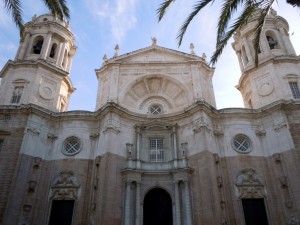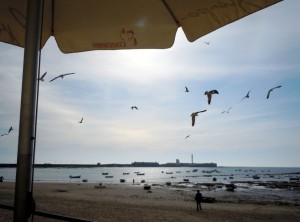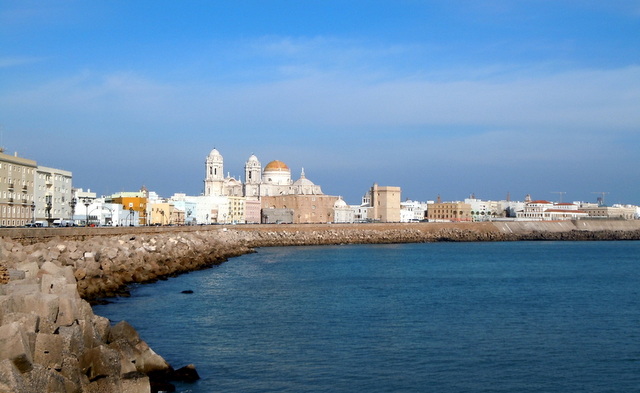One of my favourite places for a day trip is the city of Cadiz, which is less than two hours away from Seville by train on Spain’s southwest coast. Founded by the Phoenicians some three thousand years ago, it is probably the oldest city in Europe, and has always been one of the country’s most important seaports. Located at the end of a long, partly artificial promontory, and surrounded by the sea on three sides, it’s also one of the prettiest. And just the right size to walk around in an afternoon.
When you arrive make your way into the old centre through Plaza San Juan de Dios, newly renovated with little fountains, and with the impressive town hall at the far end, and head for Plaza Catedral. Grab an empanada for elevenses at the little shop opposite the baroque façade of the 18th century cathedral, which will set you up for the rest of the morning. From there, go through the Arco-de-la-Rosa into the Barrio del Populi, which is the oldest part of Cadiz, and has quite a different feel to the rest of the city. Although it’s small it’s surprisingly easy to get lost in the maze of narrow streets. Nearby on the seafront is the impressive Roman theatre, only rediscovered under some old warehouses in 1980. From there it’s another short walk to the recently reopened central market, with its impressive displays of fruit and veg, fresh meat, and especially, an enormous variety of fresh fish and seafood. It’s one of my favourite stops in Cadiz.
Time for lunch. Have some starters at Casa Manteca (The House of Lard), making sure to sample that local speciality, “chicharrones especial”, before going to Restaurante El Faro for some topnotch fish and seafood. Try the “arroz negro” (rice with squid-ink) for a special treat.
Back on the sea front turn right and follow the coastal fortifications; Castillo San Sebastian, brooding out in the bay at the end of its causeway, from one angle looking like a great ship, and Santa Catalina on the corner of the headland, looking out over the Atlantic in three directions. Stop for a drink on the seafront terrace of the Parador hotel before visiting Parque Genovése next door, a botanical garden with a wonderful collection of strange trees and an artificial waterfall, and definitely not to be missed.
Time now to be heading home, taking the direct route across the middle of the old city. The pattern of the streets here is quite regular, and it’s not hard to find your way to the two big public squares, Plaza San Antonio and Plaza Mina, monuments to 19th century civic pride. I love both these places to stop and stare for a while, but they are quite different in character, San Antonio wide and light and airy, surrounded by mansions and San Antonio church, while Plaza Mina is like a garden, filled with trees and exotic plants. It’s also the home of the Archaeological Museum. Other things to see include the Torre Tavira, the last of the old watchtowers from which the merchants would look out to see for the safe return of their ships, and the Oratorio de la Cueva, a 17th century chapel underground chapel.
How to get there: The best way to get there is by train. You can book online, at the Renfe booking office in Calle Zaragoza, or at Santa Justa station. Trains run approximately every one and a half hours, and the journey time is a little under two hours. A return ticket (ida y vuelta) costs around 25 euros.




Pingback: veoapartment goes to the beach | veoapartment